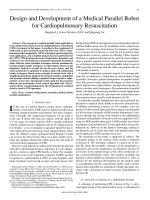Hyperscsi design and development of a new protocol for storage networking
Bạn đang xem bản rút gọn của tài liệu. Xem và tải ngay bản đầy đủ của tài liệu tại đây (2.52 MB, 169 trang )
HYPERSCSI: DESIGN AND DEVELOPMENT OF A
PROTOCOL FOR STORAGE NETWORKING
WANG YONG HONG WILSON
NATIONAL UNIVERSITY OF SINGAPORE
2005
HYPERSCSI: DESIGN AND DEVELOPMENT OF A
PROTOCOL FOR STORAGE NETWORKING
WANG YONG HONG WILSON
(M.Eng, B.Eng)
A THESIS SUBMITTED
FOR THE DEGREE OF DOCTOR OF PHILOSOPHY
DEPARTMENT OF ELECTRICAL & COMPUTER ENGINEERING
NATIONAL UNIVERSITY OF SINGAPORE
2005
i
Acknowledgements
First and foremost, I would like to thank Professor Chong Tow Chong, who took me as his
student for PhD study. I am grateful to him for giving me invaluable advice, encouragement, and
support during the past years. His expertise and good judgment in research will continuously
benefit me in my future career.
I wish to express my sincere gratitude to Dr. Jit Biswas for his help, professionalism, and
insightful comment on my thesis. I would like to thank Dr. Zhu Yaolong for his guidance and
critical review in the course of my study. Especially, I want to thank Dr. Sun Qibin for his
encouragement and recommendation, which have given me the confidence to reach this
destination.
This thesis is rooted in several research projects, where many colleagues have made
tremendous effort to help me to verify, develop and test the protocol design. Particularly, I would
like to thank the people in the HyperSCSI developing team, including Alvin Koy, Ng Tiong King,
Yeo Heng Ngi, Vincent Leo, Don Lee, Wang Donghong, Han Binhua, Premalatha Naidu, Wei
Ming Long, Huang Xiao Gang, Wang Hai Chen, Meng Bin, Jimmy Jiang, Lalitha Ekambaram
and Law Sie Yong. Special thanks to Patrick Khoo Beng Teck, the team’s manager who steered
the HyperSCSI project toward success. In addition, I also want to thank the people who helped
setup and manage the GMPLS optical testbed for the storage networking protocol evaluation,
including Chai Teck Yoong, Zhou Luying, Victor Foo Siang Fook, Prashant Agrawal, Chava
Vijaya Saradhi, and Qiu Qiang. Without these people’s effort, this thesis would not have been
possible.
I would also like to thank the Data Storage Institute, where I obtained full support for my study,
work, and research. I am grateful to Dr. Thomas Liew Yun Fook, Dr. Chang Kuan Teck, Yong
Khai Leong, Dr. Yeo You Huan, Tan cheng Ann, Dr. Gao Xianke, Dr. Xu Baoxi, Dr. Han
ii
Jinsong, Dr. Shi Luping, Ng Lung Tat, Zhou Feng, Xiong Hui, and Yan Jie for their generous
help and support.
Last but not least, I would like to thank my parents and parents-in-law for their unselfish
support. I owe a special debt of gratitude to my wife and children. The completion of this work
would have been impossible without their great patience and unwavering love and support.
iii
Contents
Acknowledgements i
Contents iii
List of Tables ix
List of Figures x
Abbreviations xiii
Summary xv
1 Introduction 1
1.1 Background and Related Work 2
1.1.1 Evolution of Storage Networking Technologies 2
1.1.2 Storage Networking Protocols 5
1.1.2.1 Fibre Channel 6
1.1.2.2 Internet SCSI 7
1.1.2.3 Fibre Channel over TCP/IP 8
1.1.2.4 Internet Fibre Channel Protocol 9
1.2 Problem Statements and Research Motivation 9
1.2.1 Fibre Channel Cost and Scalability Issues 9
1.2.2 Performance Issues for TCP/IP-based SAN 10
1.2.3 Motivation for Designing a new Protocol 11
1.3 Research Contributions of the Thesis 12
1.4 Organization of Thesis 13
iv
2 Data Transport Protocols Review 15
2.1 General-Purposed Protocols 15
2.1.1 Internet Protocol 16
2.1.2 User Datagram Protocol 16
2.1.3 Transmission Control Protocol 17
2.2 Lightweight Transport Protocols for High-Speed Networks 22
2.2.1 NETBLT: Network Block Transfer 22
2.2.2 VMTP: Versatile Message Transport Protocol 23
2.2.3 XTP: Xpress Transport Protocol 23
2.3 Lightweight Transport Protocols for Optical Networks 25
2.3.1 RBUDP: Reliable Blast UDP 25
2.3.2 SABUL: Simple Available Bandwidth Utilization Library 26
2.3.3 GTP: Group Transport Protocol 26
2.3.4 Zing 27
2.4 Summary 28
3 HyperSCSI Protocol Design 29
3.1 Design Rationale 29
3.2 Protocol Description 31
3.2.1 Protocol Architecture Overview 31
3.2.2 HyperSCSI Protocol Data Structures 33
3.2.2.1 HyperSCSI PDU 33
3.2.2.2 HyperSCSI packet over Ethernet 34
3.2.2.3 HyperSCSI Command Block Encapsulation 35
v
3.2.3 HyperSCSI State Transitions 36
3.2.4 HyperSCSI Protocol Operations 40
3.2.4.1 Typical Connection Setup 40
3.2.4.2 Flow Control and ACK Window setup 41
3.2.4.3 HyperSCSI Data Transmission 42
3.2.4.4 Connection Maintenance and Termination 43
3.2.4.5 HyperSCSI Error Handling 44
3.3 HyperSCSI Key Features Revisited 46
3.3.1 Flow Control Mechanisms 46
3.3.1.1 Fibre Channel 46
3.3.1.2 iSCSI with TCP/IP 47
3.3.1.3 HyperSCSI 49
3.3.2 Integrated Layer Processing 52
3.3.2.1 ILP for Data Path optimization 53
3.3.2.2 Reliability across Layers 53
3.3.3 Multi-Channel Support 54
3.3.4 Storage Device Options Negotiation 56
3.3.5 Security and Data Integrity Protection 57
3.3.6 Device Discovery Mechanism 59
3.4 Summary 60
4 Performance Evaluation and Scalability 63
4.1 Performance Evaluation in a Wired Environment 63
4.1.1 Description of Test Environment 63
vi
4.1.2 HyperSCSI over Gigabit Ethernet 65
4.1.2.1 Single SCSI Disk 65
4.1.2.2 RAID0 68
4.1.2.3 RAM Disk 70
4.1.3 HyperSCSI over Fast Ethernet 72
4.1.4 Performance Comparisons 74
4.1.4.1 End System Overheads Comparison 74
4.1.4.2 Packet Number Efficiency Comparison 79
4.1.4.3 File Access Performance Comparison 81
4.2 Support for Cost Effective Data Shared Cluster 82
4.3 Performance Evaluation in a Wireless Environment 85
4.3.1 HyperSCSI over Wireless LAN (IEEE 802.11b) 86
4.3.2 TCP Performance over Wireless LAN (802.11b) 87
4.3.3 HyperSCSI Performance with Encryption & Hashing 88
4.3.4 Performance Comparisons 89
4.4 Applying HyperSCSI over Home Network 90
4.5 Summary 92
5 Protocol Design for Remote Storage over Optical Networks 94
5.1 Optical Network Evolution 94
5.2 Remote Storage over MAN and WAN 96
5.3 Network Storage Protocol Design over GMPLS based Optical Network 98
5.3.1 GMPLS Control Plane 98
5.3.1.1 Routing Module 99
vii
5.3.1.2 Signaling Module 99
5.3.1.3 Link Management Module 99
5.3.1.4 Network Management Module 100
5.3.1.5 Node Resident Module 100
5.3.2 Integrated Design Issues for Storage Networking 100
5.3.2.1 Separate Protocol for Data Path and Control Path 100
5.3.2.2 HyperSCSI Protocol Redesign 102
5.4 Deploy HyperSCSI over ONFIG Testbed 103
5.5 Field Trial and Experimentation 106
5.5.1 Connectivity Auto-discovery 106
5.5.2 Lightpath Setup 107
5.5.3 Effect of Fiber Length on TCP Performance 109
5.5.4 Routing Convergence Time 109
5.5.5 iSCSI and HyperSCSI Wide-area SAN performance comparison 110
5.5.5.1 Performance Comparison on Single Disk 110
5.5.5.2 Performance Comparison on RAID 113
5.5.6 Service Resilience 115
5.6 Summary 117
6 Conclusions and Future Work 119
6.1 Summary of HyperSCSI Protocol 119
6.2 Summary of Contributions 121
6.3 Future Work 123
References 125
viii
Author’s Publications 137
Appendix: HyperSCSI Software Modules 139
A.1 Software Design 139
A.1.1 HyperSCSI Client / Server Definition 139
A.1.2 HyperSCSI Device Identification 140
A.1.3 Interface between SCSI and HyperSCSI Layer 141
A.1.4 Network routines 142
A.2 Programming Architecture 142
A.2.1 HyperSCSI Root 143
A.2.2 HyperSCSI Doc 144
A.2.3 HyperSCSI common 145
A.2.4 HyperSCSI Server 146
A.2.5 HyperSCSI client 147
A.2.6 HyperSCSI Final Modules 148
A.3 Installation and Usage 148
A.3.1 Installation 148
A.3.2 Usage 149
ix
List of Tables
Table 1.1 Evolution of storage networking technologies 3
Table 1.2 Fibre Channel layers 6
Table 3.1 Common standard network protocols comparison 30
Table 3.2 HyperSCSI operations codes descriptions 40
Table 3.3 Comparison of three storage networking protocol features 45
Table 3.4 Categories of HyperSCSI device options 56
Table 4.1 Single disk performance over Gigabit Ethernet with normal frame 65
Table 4.2 Single disk performance over Gigabit Ethernet with jumbo frame 65
Table 4.3 Performance comparison between Raid0 over Gigabit Ethernet with local
system 69
Table 4.4 HyperSCSI network packet number versus Ethernet MTU 80
Table 4.5 Network packet number comparison for iSCSI and HyperSCSI 80
Table 5.1 Effect of switch configuration time on routing convergence time with and
without protection lightpaths 110
x
List of Figures
Figure 1.1 Fibre Channel (FC) interconnections topologies 7
Figure 1.2 iSCSI storage network application over Ethernet/Internet 8
Figure 3.1 HyperSCSI architecture 32
Figure 3.2 HyperSCSI Protocol Data Unit (PDU) with header block template 33
Figure 3.3 HyperSCSI packet and header 34
Figure 3.4 HyperSCSI Command Block (HCBE) structure 35
Figure 3.5 HyperSCSI server node state transition diagram 38
Figure 3.6 HyperSCSI client node state transition diagram 39
Figure 3.7 HyperSCSI connection setup 41
Figure 3.8 HyperSCSI packet flow control 42
Figure 3.9 HyperSCSI data transmission 43
Figure 3.10 Fibre Channel credit based flow control mechanism 47
Figure 3.11 TCP and SCSI protocol flow control mechanisms 47
Figure 3.12 HyperSCSI flow control and packet group mechanism 49
Figure 3.13 HyperSCSI reliability mechanism 54
Figure 3.14 Device options format in the HCC_ADN_REQUEST and REPLY 57
Figure 3.15 Authentication challenge generation verification and key exchange 58
Figure 3.16 HyperSCSI group names mapping 60
Figure 4.1 Single SCSI disk access performance over Gigabit Ethernet 67
Figure 4.2 HyperSCSI Single SCSI Disk latency measurement 68
Figure 4.3 RAID0 access performance over Gigabit Ethernet 69
Figure 4.4 Average CPU utilization for RAID0 access 70
xi
Figure 4.5 HyperSCSI RAM disk transfer rate on Gegabit Ethernet with normal and
jumbo frame size 71
Figure 4.6 HyperSCSI RAM disk CPU utilization and normalized I/O rate 71
Figure 4.7 HyperSCSI RAM disk latency measurement 72
Figure 4.8 HyperSCSI Fast Ethernet performance 73
Figure 4.9 Performance comparison between HyperSCSI and iSCSI 76
Figure 4.10 CPU utilization comparison between HyperSCSI and iSCSI 77
Figure 4.11 Performance breakdown for HyperSCSI 78
Figure 4.12 File access performance comparison 81
Figure 4.13 Multi-node concurrently access storage via Ethernet SAN with HyperSCSI
82
Figure 4.14 Multi-node data read performance of GFS with HyperSCSI 83
Figure 4.15 Multi-node data read performance with separate physical storage disk 84
Figure 4.16 Wireless HyperSCSI test system configuration with IEEE 802.11b 85
Figure 4.17 Wireless HyperSCSI read performance with IEEE 802.11b 86
Figure 4.18 Wireless HyperSCSI & TCP performance comparison 87
Figure 4.19 HyperSCSI encryption and hash performance with IEEE 802.11b 88
Figure 4.20 Performance comparison for HyperSCSI, iSCSI and NFS 90
Figure 4.21 Apply HyperSCSI protocol in home environment 91
Figure 5.1 Network architecture evolution [102] 95
Figure 5.2 ONFIG GMPLS software overview 98
Figure 5.3 HyperSCSI integrated protocol mechanism 101
Figure 5.4 ONFIG Testbed configuration with HyperSCSI / iSCSI client and servers 104
xii
Figure 5.5 Port connectivity information 106
Figure 5.6 Schematic of link termination 107
Figure 5.7 Signaling message sequence 108
Figure 5.8 Remote storage dd test on a single disk 111
Figure 5.9 Remote storage hdparm test on a single disk 111
Figure 5.10 Remote storage files access comparison on a single disk 112
Figure 5.11 Remote storage dd test on RAID0 113
Figure 5.12 Remote storage hdparm read test on RAID0 114
Figure 5.13 Remote storage files access comparisons on RAID0 115
Figure 5.14 Lightpath failover between (a) IP Routers (b) Optical Nodes 116
Figure A.1 HyperSCSI client and server software model 139
Figure A.2 HyperSCSI source code tree 143
Figure A.3 Starting the HyperSCSI server 150
Figure A.4 Starting the HyperSCSI client 150
Figure A.5 Displaying the HyperSCSI server status 151
Figure A.6 Displaying the HyperSCSI client status 151
xiii
Abbreviations
AIMD Additive Increase Multiplicative Decrease
ALF Application Layer Framing
ATM Asynchronous Transfer Mode
DAS
Direct Attached Storage
DWDM Dense Wavelength Division Multiplexing
FC Fibre Channel
FCIP Fibre Channel over TCP/IP
GFS Global File System
GMPLS Generalized Multi-protocol Label Switch
GTP Group Transport Protocol
HBA Host Bus Adapter
IDE Integrated Drive Electronics technology
iFCP Internet Fibre Channel Protocol
ILP Integrated Layer Processing
IP Internet Protocol
iSCSI Internet SCSI
iSNS Internet Storage Name Server
ISP ISP: Internet Service Provider
LAN Local Area Network
MAN
Metropolitan Area Network
MPLS Multi-protocol Label Switch
NAS
Network Attached Storage
NASD Network Attached Secure Disk
NETBLT Network Block Transfer
ONFIG Optical Network Focused Interest Group
PDU Protocol Data Unit
RAID Redundant Arrays of Independent Disks
RBUDP Reliable Blast UDP
RDMA Remote Direct Memory Access
RTO Round Trip Timeout
RTT Round Trip Time
xiv
SAN
Storage Area Network
SABUL Simple Available Bandwidth Utilization Library
SCSI Small Computer System Interface
SONET Synchronous Optical Network
SSP Storage Service Provider
TCP Transmission Control Protocol
TOE TCP offload engine
UDP User Datagram Protocol
VISA Virtual Internet SCSI Adapter
VLAN Virtual LAN
VMTP Versatile Message Transport Protocol
WAN
Wide Area Network
WLAN
Wireless LAN
XTP Xpress Transmission Protocol
xv
Summary
In response to the trend of the rapidly growing volume of and the increasingly critical role
played by data storage, there is a strong demand to put data storage on network. Therefore, how
to share data, improve data reliability, and back up and restore data efficiently raises great
challenge to storage networking protocols.
In this thesis, we propose a new storage networking protocol, called HyperSCSI, to provide
transmission of SCSI commands and data across a common network with design optimization on
Ethernet. There are two leading storage networking protocol stacks in the market: FC (Fibre
Channel) and iSCSI (Internet Small Computer System Interface). FC is currently a dominant
technology for building storage area network (SAN). However, FC works on a separate and
dedicated network platform that requires higher cost and complexity for network installation and
maintenance. On the other hand, iSCSI, by leveraging TCP/IP protocol, supports the transmission
of SCSI protocol data over the Internet natively. Compared with FC, iSCSI shows the advantages
of flexibility, scalability, wide range interconnectivity and low cost. However, TCP protocol is
always criticized for providing poor performance in data intensive storage application
environment.
We present the details of design and development of HyperSCSI protocol on various platforms
ranging from corporate Ethernet SAN to home wireless storage network to optical long distance
network. We show that HyperSCSI has more design focus on data transportation than iSCSI,
which removes TCP/IP protocol stack in order to efficiently utilize the network bandwidth. We
propose to use integrated layer processing mechanism to guarantee the reliability of data delivery
and provide a new flow control method for storage data traffic in high-speed network
environment. As Ethernet technology keeps advancing, it is expanding itself to the field of
metropolitan area network (MAN) and even wide area network (WAN), which is beyond the
xvi
scope of its original design. HyperSCSI is therefore a suitable choice to fit such technological
trend by utilizing VLAN (virtual LAN) and GMPLS optical network to provide wide area
network storage services.
We have conducted comprehensive experiments and benchmark measurements based on real
applications. The results show that HyperSCSI can achieve significant performance improvement
over iSCSI. Throughput improvement of as high as 60% is obtained in Gigabit Ethernet
environment. HyperSCSI can achieve over 100MBps sustained data transfer rate over Gigabit
Ethernet, which is comparable to 1Gbps FC SANs, but with great reduction of complexity and
cost.
As the final conclusion, we develop HyperSCSI as a practical solution for network-based
storage applications. HyperSCSI leverages the maturity and ubiquity of Ethernet technology. It
can be applied smoothly over Fast Ethernet, Gigabit Ethernet, and even IEEE 802.11 wireless
LAN. It also supports parallel data transport with multi-channel for performance, load balancing,
and failover functions. HyperSCSI can be used to provide relatively high performance storage
data transport with much less cost and complexity. HyperSCSI can also be applied to implement
flexible storage-based home network with both wire and wireless support. As a whole, we believe
that HyperSCSI can be a key component in serving network storage applications in the future
connected digital world.
Chapter 1 Introduction
1
Chapter 1
1 Introduction
During the past decade, data intensive applications have been developed rapidly, thus opening
up the possibility for new service paradigms with great potential. Examples of such applications
are email, multimedia, distributed computing, and e-commerce. As a result, the demand for
storage has grown at an amazing speed. The amount of data stored is at least doubling every year
[1, 2]. It is estimated that 5 exabytes of new information was generated in 2002 alone [4].
Traditionally, storage is considered part of a computer system as a peripheral or subsystem.
Such model is called DAS (Direct Attached Storage), which contains the storage resource directly
attached to the application servers. In response to the trend of the rapidly growing volume of and
the increasingly critical role played by data storage, two more storage networking models have
been developed: NAS (Network Attached Storage) and SAN (Storage Area Network) [1, 2, 3, 5].
With this development in storage networking, great advantages have been achieved in sharing
storage resource in terms of scalability, flexibility, availability, and reliability. NAS refers to a
storage system that connects to the existing network and provides file access services to computer
systems, or users. A NAS system normally works together with users on the same network
infrastructure as data is transferred to and from the storage system by using TCP/IP data transport
protocol. A SAN is a separate network whose primary purpose is the transfer of data between
computer systems, or servers, and storage elements, and among storage elements. SAN is
sometimes called “the network behind the servers” [6]. It enables servers to access storage
resource in the fundamental block level to avoid file system overhead. Compared with NAS, a
SAN adopts a unique protocol that combines storage devices and network infrastructure
Chapter 1 Introduction
2
efficiently. In doing so, SAN can provide the benefits of performance, scalability, and resource
manageability to storage applications.
Building SAN is essentially a way of applying network technologies for the interconnection
between application servers and storage devices or subsystems. SANs need to address a set of
characteristics, which are required by the applications [7, 8, 9], such as high throughput, high
bandwidth utilization, low latency, low system overheads, and high reliability. Storage
networking technologies play an important role in guaranteeing better performance of data
transportation for network storage systems. In this chapter, we review the background and related
work about storage networking technologies and protocols. Next, we discuss the problems related
to existing protocols. We also present the motivation of our work for the design and development
of a new protocol for storage networking. Finally, we summarize the research contributions of
this thesis.
1.1 Background and Related Work
1.1.1 Evolution of Storage Networking Technologies
The evolution of storage networking technologies can be classified into three phases as shown
in Table 1.1. The first phase started with the introduction of the protocols that were specially
designed for dedicated network hardware, such as HiPPI (High Performance Parallel Interface),
SSA (Serial Storage Architecture), FC (Fibre Channel), Infiniband, to name a few. These
protocols together with their associated network hardware architectures provided high
performance and reliable channel in proprietary situation. However, these approaches have been
under growing pressure, because of the fact that these special purpose protocols and dedicated
systems increase cost and complexity for system configuration and maintenance, hindering their
widespread acceptance [8, 10]. Thus, while these protocols are still in use and continue to be
developed today, only the FC is a mostly deployed technology used to support the building of
high performance SANs in an enterprise environment.
Chapter 1 Introduction
3
Table 1.1: Evolution of storage networking technologies
Phase 1
Special purpose networking protocols over dedicated
network infrastructure
HiPPI, SSA,
FC, Infinband
Phase 2
Common standard network protocols over standard
network infrastructure with minimum modification
VISA,
NASD,
iSCSI
Phase 3
Standard network protocols with optimized (or fine
tuned) features over standard network infrastructure
or with emerging network technologies
iSCSI with TOE
iSCSI HBA
iSCSI with RDMA
Storage over DWDM
In the mid-1990s, researchers began investigating the feasibility of adopting common standard
network infrastructure and protocols to support storage applications. We categorize this as the
second phase for storage networking, because the development during this period used existing
transport protocols as storage carrier with minimum modification. For instance, the Netstation
project at University of Southern California’s Information Science Institute designed a block level
SAN protocol over Internet platforms in 1991 [11, 12, 13]. By using this protocol, a virtual SCSI
interface architecture was built, termed VISA (Virtual Internet SCSI Adapter) [13], which
enabled the applications to access the so-called derived virtual device (DVD) [12] over the
Internet. In this project, UDP/IP was used for data transportation with additional reliability
function on top. It assumed data in-order delivery and employed a fixed-size data transmission
window and ACK control. It also investigated the possibility of adopting TCP as transport
protocol to support its storage architecture, the purpose of which was to provide an Internet
protocol for network-attached peripherals [14].
At the same time, the NASD (network attached secure disk) from the Carnegie Mellon
University’s parallel data lab provided storage architecture that separated the functionalities
between a network file manager (or server) from disk drivers in order to offload operations, such
as read and write from file manager [15]. The main feature of such an approach was that it
enabled a network client, after acquiring access permission from the file manager, to access data
directly from a storage device, the result of which was better performance and security. Within
this model, data transportation was served by the RPC (remote procedure call) request and
Chapter 1 Introduction
4
response scheme. At this time, all the proposals were on top of the IP layer, since various link
layer protocols, such as Ethernet, FDDI (Fiber Distribute Data Interface), Token Ring, ATM
(Asynchronous Transfer Mode), and Myrinet, etc, were used underneath. IP protocol enabled the
wide area connectivity and bridging across heterogeneous system environment. Therefore, both
UDP and TCP were proposed to transport the data traffic for storage applications [16, 17].
Ethernet has proved to be a successful network technology [18] and has become dominant in a
LAN environment. It is estimated that 90 percent of data network traffic originates from or
terminates at Ethernet [19]. The familiarity with this technology of enterprise customers and the
volume of scale have made Ethernet infrastructure very cost effective. Together with the advance
of Gigabit or even 10 Gigabit Ethernet, higher performance is in principle available on an
Ethernet-based network. As IP and Ethernet are deployed ubiquitously, especially when Gigabit
Ethernet has become mature and common, TCP became a choice for transporting storage data
traffic on top of IP and Ethernet due to its reliability features. This has motivated IBM, Cisco, and
others to develop a storage networking protocol over the Internet, which resulted in the iSCSI
(Internet Small Computer System Interface) [6, 20, 21].
However, with the high network bandwidth available today, common network transport
protocol, especially TCP, shows the limitations for high performance network storage
applications, which will be described in a section that follows. These limitations lead us to the
third phase of storage networking, in which we find several approaches geared toward meeting
the requirements of storage applications. One set of the approaches involves developing hardware
accelerators, such as iSCSI SAN with TCP offload engine (TOE) or even with iSCSI offload
engine (iSCSI HBA). New data mapping mechanisms, such as Remote Direct Memory Access
(RDMA) are also proposed in an effort to reduce memory copy overhead involved by traditional
TCP implementation. Although these approaches improve the system performance in some
situations, they increase the cost and complexity of infrastructure deployment and maintenance.
Chapter 1 Introduction
5
With the maturity and dominance of Ethernet, we believe that there is the trend of delivering
storage service on an Ethernet-based network with a much simplified data transport protocol.
Furthermore, Ethernet is gradually expanding to metropolitan and wide area with the methods
both from the physical layer (layer 1) and the protocol layer (layer 2). From the physical layer
perspective, by using the DWDM (Dense Wavelength Division Multiplexing), SONET
(Synchronous Optical Network), and ATM technologies, Ethernet frames can be tunneled over a
long distance to form a point-to-point connection [1, 22]. From layer 2 perspective, Ethernet
frame can be encapsulated by either VLAN (Virtual LAN) or MPLS (Multi-protocol Label
Switch) technologies in order to create a logical LAN (or broadcast domain) over a wide area
[19]. All these indicate that Ethernet, as a dominant technology, is being used to unify the
network environment from local to metropolitan to wide area coverage.
With the characteristics of SAN data traffic and network architecture, together with the
simplicity and efficiency of Ethernet, we believe that there is less demand for data transport
protocol to provide sophisticated features, like TCP, for intensive storage data transfer. Therefore,
it is necessary to propose a new approach to serve the storage applications that need a large
amount of data transfer.
1.1.2 Storage Networking Protocols
Networking protocol is the key component that enables a network storage system to provide
high bandwidth, large scale, and long-distance connectivity at a cost that makes network storage
model an attractive alternative. In this section, we will highlight some popular storage networking
protocols that are fundamental to building network storage systems.
The storage networking protocol is a set of rules for the communication and data exchange
between computer servers and storage devices. There are several storage networking protocol
stacks in the market, some of which are in the process of being standardized. The two major
protocols are FC and iSCSI. There are other protocols, which are mainly combinations or
variations of Fibre Channel and IP network protocols [1, 6, 23].
Chapter 1 Introduction
6
1.1.2.1 Fibre Channel
Fibre Channel (FC) was initiated by ANSI in the late 1980s. It is a serial technology that
transmits data in stream at high speed [1]. FC was developed to support storage applications, and
is in fact the main component behind the SAN. The FC protocol maps the SCSI storage protocol
into a network environment, and extends the connectivity to a distance longer than the directly
attached DAS storage system. Therefore, FC SAN serves the storage applications with a faster
data transfer rate, longer distance, and larger number of storage device interconnection.
Table 1.2: Fibre Channel layers
Layer Function
FC-4 Upper-layer protocol interfaces
FC-3 Common services and Group Control
FC-2 Network Access and Data Link control
FC-1 Transmission Control
FC-0 Media and Transceivers
FC is a standard-based networking protocol with layered architecture. Table 1.2 lists the layers
in FC standard definition. With the gigabit-speed data transmission, FC supports both copper and
fiber optic components and has its own framing structure and flow control mechanism. An FC
network can support three interconnected topologies, namely point-to-point connection, arbitrated
loop, and switched fabric. Figure 1.1 illustrates FC networks with different topologies. FC
increases the number of device to 126 in looped structure and 16 million in switched structure,
whereas the original SCSI storage protocol only supports at most 15 devices on the bus.
FC is the major technology used to build SAN, mostly due to the increasing demand of current
business conditions for storage management, backup, and disaster recovery. With many years of
experience, FC has been accepted as standard and undergoes the path to provide 1Gbps, 2Gbps,
and 4Gbps (10Gbps is in planning) channel bandwidth capability. In today’s high-end corporate
network storage deployment strategy, FC is still the prime choice. However, it is a network
protocol that requires a dedicated network infrastructure, which may not be affordable to middle
Chapter 1 Introduction
7
range or small enterprise. It thus faces a strong challenge from iSCSI due to the factors of cost
and network popularity.
1.1.2.2 Internet SCSI
Internet SCSI (iSCSI) is a newly proposed industry standard that allows SCSI data to be
transported over the Internet by leveraging the popular TCP/IP Internet protocol [20, 23]. This is
an analogous way in which the SCSI command is mapped onto Fibre Channel. The basic system
model for iSCSI is its creation of a virtual extended cable that connects a SCSI initiator device to
a SCSI target device natively in an IP-based network environment. An iSCSI device is identified
by its IP address through the name that is managed by an Internet storage name server, or iSNS,
for the whole network. iSCSI is a connection oriented protocol. An iSCSI session begins with an
iSCSI login, which may include initiator and target authentication, session security certificates,
and option parameters. Once the iSCSI login is successfully completed, it moves to the next
phase, which is called full feature phase. The initiator may then send SCSI commands and data to
(a)
(b)
(c)
Storage
Devices
Storage
Devices
Storage
Devices
Server
Server
Server
Server
Servers
Switch
Fabric
(a)
(b)
(c)
Storage
Devices
Storage
Devices
Storage
Devices
Server
Server
Server
Server
Servers
Switch
Fabric
Figure 1.1: Fibre Channel (FC) interconnections topologies
(a) Point-to-point;
(b) Arbitrated loop;
(c) Switch fabric









